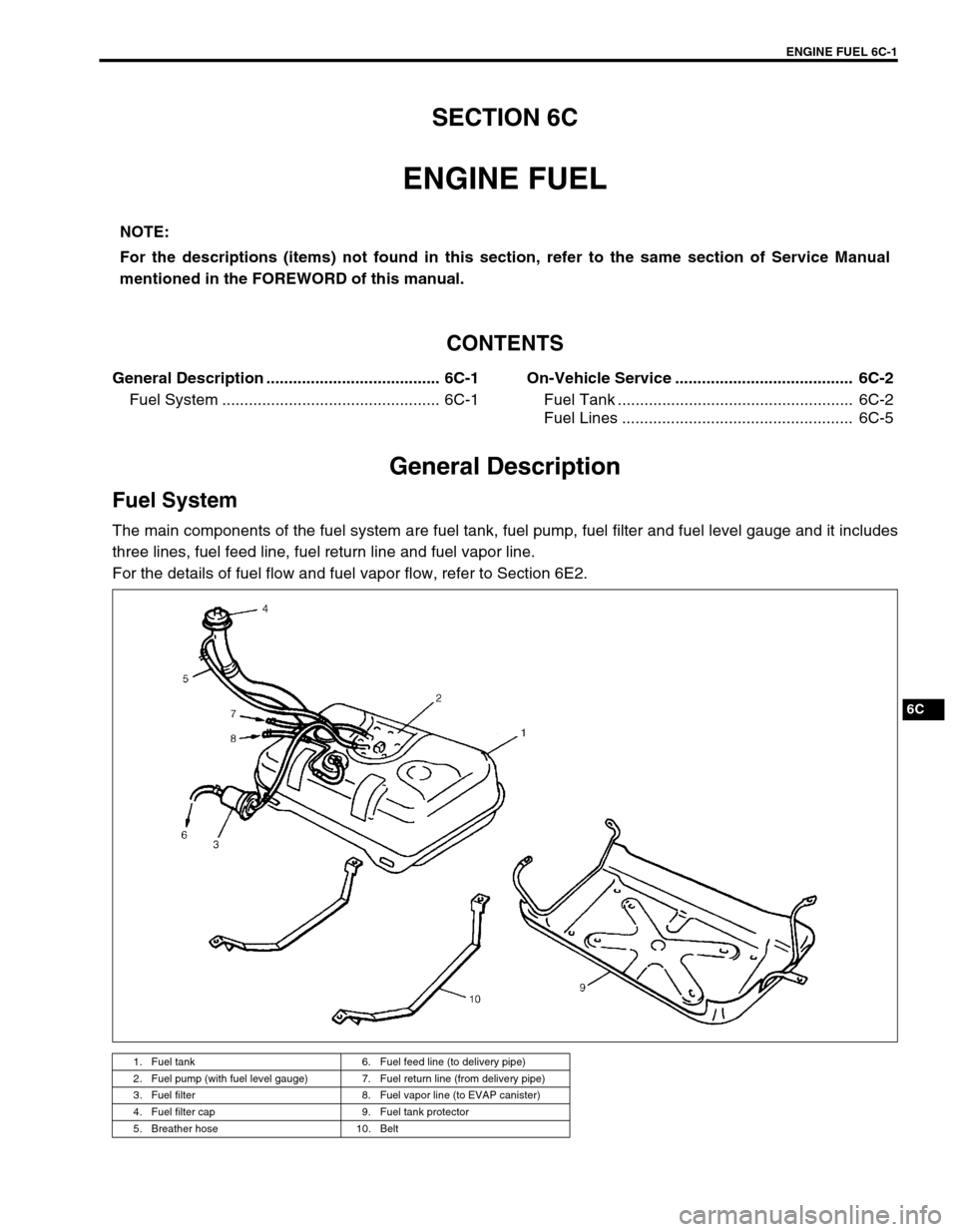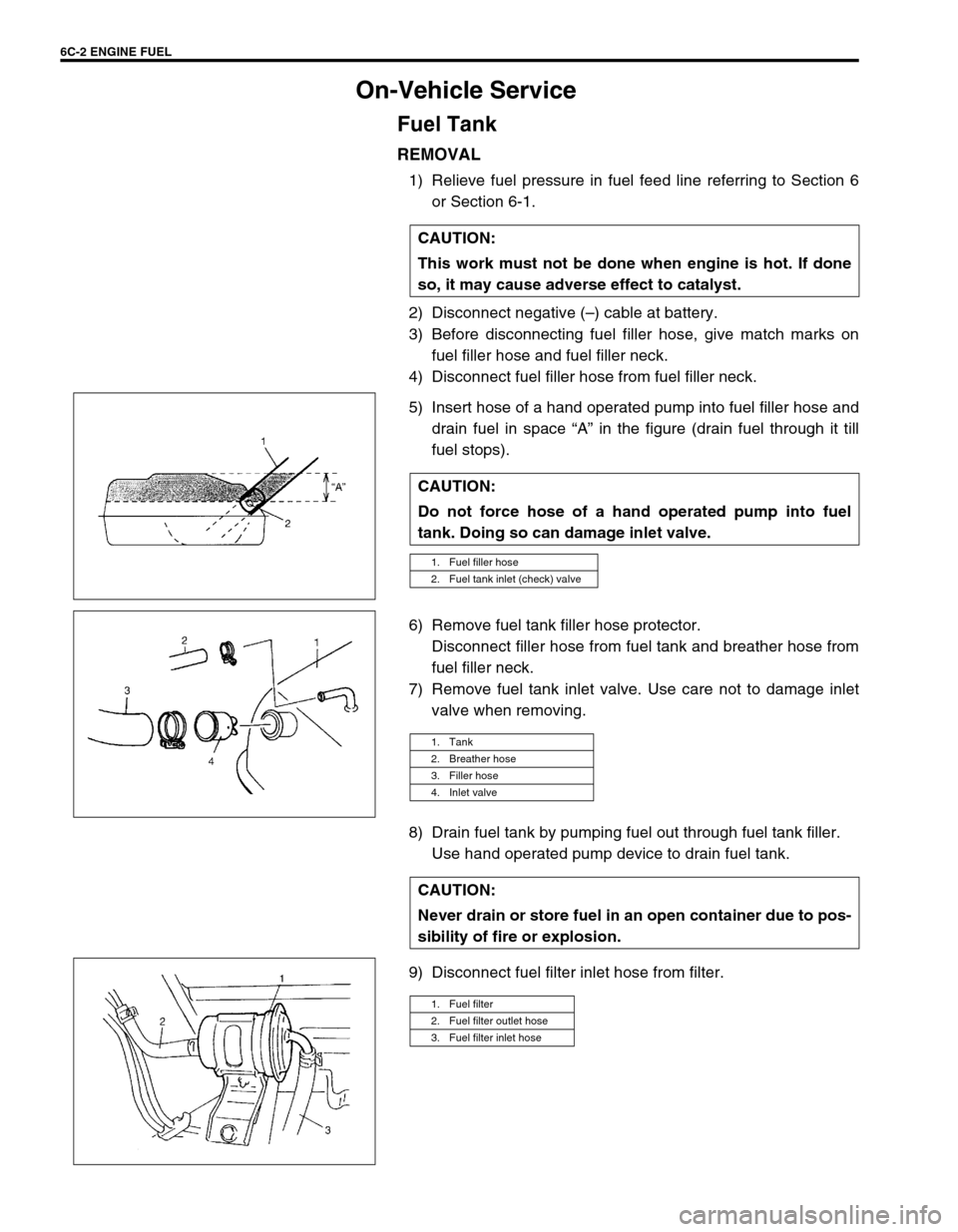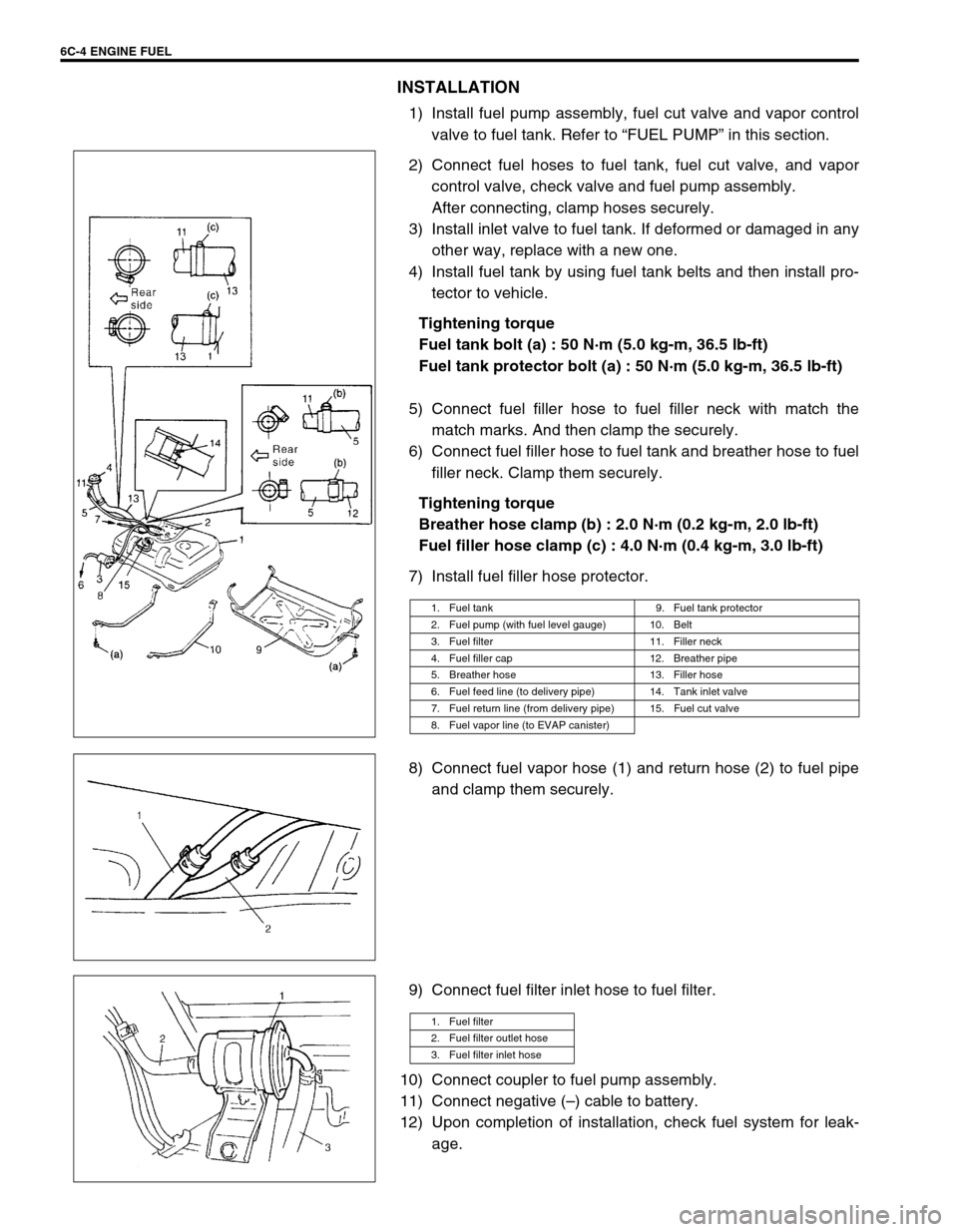Page 290 of 656
ENGINE MECHANICAL (H27 ENGINE) 6A2-3
REMOVAL
1) Release fuel pressure in fuel feed line by referring to Section
6.
2) Disconnect negative (–) cable at battery.
3) Drain coolant.
4) Remove strut tower bar (2).
5) Disconnect coupler from intake air temp. sensor, and MAF
sensor.
6) Remove surge tank cover (1).
7) Remove air cleaner upper case, intake air hose, intake air
pipe (1) and surge tank pipe (2) as one component. Do not
disassemble them, when removing and reinstalling. CAUTION:
This work must not be done when engine is hot. If done
so, it may cause adverse effect to catalyst.
WARNING:
To help avoid danger of being burned, do not remove
drain plug and radiator cap while engine and radiator are
still hot. Scalding fluid and steam can be blown out under
pressure if plug and cap are taken off too soon.
1. Radiator
2. Radiator drain plug
2
1
1
2
Page 313 of 656
6A2-26 ENGINE MECHANICAL (H27 ENGINE)
Unit Repair Overhaul
Engine Assembly
REMOVAL
1) Release fuel pressure in fuel feed line. Refer to “FUEL
PRESSURE RELIEF PROCEDURE” in Section 6.
2) Disconnect negative (–) cable at battery.
3) Remove engine hood.
4) Drain engine oil.
5) Drain coolant.
6) Remove radiator, radiator fan shroud, cooling fan and radia-
tor reservoir. Refer to “COOLING FAN AND FAN CLUTCH”
and “RADIATOR” in Section 6B.
7) Disconnect accelerator cable (1) and A/T throttle cable (for
A/T vehicle) (2) from throttle body.
8) Remove strut tower bar and surge tank cover.
9) Disconnect IAT sensor coupler and MAF sensor coupler then
remove air cleaner upper case, intake air hose, intake air
pipe and surge tank pipe as a component.
10) Remove engine oil level gauge guide and A/T fluid level
gauge guide (for A/T vehicle).
11) Remove ignition coil covers.
12
Page 314 of 656

ENGINE MECHANICAL (H27 ENGINE) 6A2-27
12) Disconnect the following electric lead wires :
•Injector wire coupler
•CMP sensor coupler
•Ignition coil couplers
•CKP sensor coupler
•MAP sensor coupler
•TP sensor (1) coupler
•IAC valve (2) coupler
•Earth wire (3) from surge tank
•EVAP canister purge valve coupler
•EGR valve coupler
•Oxygen sensor -1 and -2 couplers referring to “Exhaust Man-
ifold” in this section
•Coolant temperature sensor coupler
•Knock sensor coupler
•Generator wires
•Starter wires
•Oil pressure wire
•P/S pump wire
•Earth wire from generator bracket
•Engine block heater (if equipped)
13) Remove clamps and brackets.
14) Disconnect the following hoses :
•Heater hose from heater water pipe
•Heater hose from water outlet cap
•EVAP canister hose from canister pipe
•Brake booster vacuum hose
15) Remove EVAP canister purge valve (5).
16) Disconnect the following hoses at the location shown in the
figure :
•Fuel feed hose (1) from fuel feed pipe
•Fuel return hose from (2) fuel return pipe
17) Remove P/S pump assembly. Refer to “POWER STEERING
PUMP” in Section 3B1.
18) Remove A/C compressor assembly. Refer to “COMPRES-
SOR ASSEMBLY” in Section 1B.
19) Remove steering shaft lower assembly. Refer to “STEERING
LOWER SHAFT ASSEMBLY” in Section 3C1.
20) Raise vehicle.
21) Remove front differential housing with differential from chas-
sis if equipped. Refer to “DISMOUNTING” in Section 7E.
22) Remove exhaust No.1 pipe. Refer to “EXHAUST MANI-
FOLD” in this section.
23) Remove exhaust manifold stiffener from transmission.
4. Clamp bracket
6. EGR valve
7. Heater hose
2
14
3
75
6
Page 328 of 656

ENGINE FUEL 6C-1
6C
SECTION 6C
ENGINE FUEL
CONTENTS
General Description ....................................... 6C-1
Fuel System ................................................. 6C-1On-Vehicle Service ........................................ 6C-2
Fuel Tank ..................................................... 6C-2
Fuel Lines .................................................... 6C-5
General Description
Fuel System
The main components of the fuel system are fuel tank, fuel pump, fuel filter and fuel level gauge and it includes
three lines, fuel feed line, fuel return line and fuel vapor line.
For the details of fuel flow and fuel vapor flow, refer to Section 6E2.NOTE:
For the descriptions (items) not found in this section, refer to the same section of Service Manual
mentioned in the FOREWORD of this manual.
1. Fuel tank 6. Fuel feed line (to delivery pipe)
2. Fuel pump (with fuel level gauge) 7. Fuel return line (from delivery pipe)
3. Fuel filter 8. Fuel vapor line (to EVAP canister)
4. Fuel filter cap 9. Fuel tank protector
5. Breather hose 10. Belt
Page 329 of 656

6C-2 ENGINE FUEL
On-Vehicle Service
Fuel Tank
REMOVAL
1) Relieve fuel pressure in fuel feed line referring to Section 6
or Section 6-1.
2) Disconnect negative (–) cable at battery.
3) Before disconnecting fuel filler hose, give match marks on
fuel filler hose and fuel filler neck.
4) Disconnect fuel filler hose from fuel filler neck.
5) Insert hose of a hand operated pump into fuel filler hose and
drain fuel in space “A” in the figure (drain fuel through it till
fuel stops).
6) Remove fuel tank filler hose protector.
Disconnect filler hose from fuel tank and breather hose from
fuel filler neck.
7) Remove fuel tank inlet valve. Use care not to damage inlet
valve when removing.
8) Drain fuel tank by pumping fuel out through fuel tank filler.
Use hand operated pump device to drain fuel tank.
9) Disconnect fuel filter inlet hose from filter.CAUTION:
This work must not be done when engine is hot. If done
so, it may cause adverse effect to catalyst.
CAUTION:
Do not force hose of a hand operated pump into fuel
tank. Doing so can damage inlet valve.
1. Fuel filler hose
2. Fuel tank inlet (check) valve
1. Tank
2. Breather hose
3. Filler hose
4. Inlet valve
CAUTION:
Never drain or store fuel in an open container due to pos-
sibility of fire or explosion.
1. Fuel filter
2. Fuel filter outlet hose
3. Fuel filter inlet hose
Page 330 of 656
ENGINE FUEL 6C-3
10) Disconnect fuel vapor hose and return hose from pipes.
11) Remove fuel tank protector (if equipped) from vehicle.
12) Lower fuel tank gradually while holding it horizontally and
pull out coupler at fuel pump.
INSPECTION
After removing fuel tank, check hoses and pipes connected to
fuel tank for leaks, loose connections, deterioration or damage.
Also check fuel pump and level gauge gaskets for leaks, visually
inspect fuel tank for leaks and damage.
Replace any damaged or malconditioned parts.
1. Fuel pump
2. Coupler
Page 331 of 656

6C-4 ENGINE FUEL
INSTALLATION
1) Install fuel pump assembly, fuel cut valve and vapor control
valve to fuel tank. Refer to “FUEL PUMP” in this section.
2) Connect fuel hoses to fuel tank, fuel cut valve, and vapor
control valve, check valve and fuel pump assembly.
After connecting, clamp hoses securely.
3) Install inlet valve to fuel tank. If deformed or damaged in any
other way, replace with a new one.
4) Install fuel tank by using fuel tank belts and then install pro-
tector to vehicle.
Tightening torque
Fuel tank bolt (a) : 50 N·m (5.0 kg-m, 36.5 lb-ft)
Fuel tank protector bolt (a) : 50 N·m (5.0 kg-m, 36.5 lb-ft)
5) Connect fuel filler hose to fuel filler neck with match the
match marks. And then clamp the securely.
6) Connect fuel filler hose to fuel tank and breather hose to fuel
filler neck. Clamp them securely.
Tightening torque
Breather hose clamp (b) : 2.0 N·m (0.2 kg-m, 2.0 lb-ft)
Fuel filler hose clamp (c) : 4.0 N·m (0.4 kg-m, 3.0 lb-ft)
7) Install fuel filler hose protector.
8) Connect fuel vapor hose (1) and return hose (2) to fuel pipe
and clamp them securely.
9) Connect fuel filter inlet hose to fuel filter.
10) Connect coupler to fuel pump assembly.
11) Connect negative (–) cable to battery.
12) Upon completion of installation, check fuel system for leak-
age.
1. Fuel tank 9. Fuel tank protector
2. Fuel pump (with fuel level gauge) 10. Belt
3. Fuel filter 11. Filler neck
4. Fuel filler cap 12. Breather pipe
5. Breather hose 13. Filler hose
6. Fuel feed line (to delivery pipe) 14. Tank inlet valve
7. Fuel return line (from delivery pipe) 15. Fuel cut valve
8. Fuel vapor line (to EVAP canister)
1. Fuel filter
2. Fuel filter outlet hose
3. Fuel filter inlet hose
Page 338 of 656

ENGINE AND EMISSION CONTROL SYSTEM (SEQUENTIAL MULTIPORT FUEL INJECTION FOR H27 ENGINE) 6E2-5
1. Air cleaner 22. Fuel level sensor 39. A/C controller (if equipped)
2. Intake air temp. sensor 23. Monitor connector (if equipped) 40. Data link connector/Immobilizer control mod-
ule (if equipped)
3. Mass air flow sensor 23-1. Diag. switch terminal 41. ABS control module
4. EVAP canister purge valve 23-2. Test switch terminal 42. Main relay
5. Throttle position sensor 23-3. Output duty select switch terminal 43. Ignition switch
6. Idle air control valve 23-4. Duty output terminal 44. Park/Neutral position switch in TR switch (A/T)
7. Camshaft position sensor 24. Fuel filter 45. Battery
8. EGR valve 25. Fuel pressure regulator 46. Starter magnetic switch
9. Manifold absolute pressure sensor
(if equipped)26. Immobilizer indicator lamp (if equipped) 47.“O/D OFF” lamp (A/T)
10. Fuel injector 27. Tank pressure control valve 48.“POWER” lamp (A/T)
11. PCV valve 28. EVAP canister 49. Lighting switch (A/T)
12. Ignition coil assembly 29. Knock sensor 50. Stop lamp switch (A/T)
13. Engine coolant temperature sensor 30. ECM/PCM (Engine control module/Powertrain con-
trol module)51. O/D cut switch (A/T)
14. Heated oxygen sensor
(bank 1 sensor 1) (if equipped)31. Malfunction indicator lamp 52. POWER/NORMAL change switch (A/T)
15. Heated oxygen sensor
(bank 2 sensor 1) (if equipped)32. Electric loads (rear defogger (if equipped), lighting) 53. 4WD low switch (A/T)
16. Heated oxygen sensor
(bank 1 sensor 2) (if equipped)33. Power steering pressure switch 54. Transmission range switch (A/T)
17. Heated oxygen sensor
(bank 2 sensor 2) (if equipped)34. Heater blower fan switch 55. Solenoid valve A (A/T)
18. Warm-up three way catalytic converter
(if equipped)35. Cruise control module 56. Solenoid valve B (A/T)
19. Three way catalytic converter
(if equipped)36. Vehicle speed sensor 57. TCC solenoid valve (A/T)
20. Crankshaft position sensor
(if equipped)37. Combination meter 58. A/T input speed sensor (A/T)
21. Fuel pump 38. A/C condenser fan relay (if equipped) 59. A/T vehicle (output) speed sensor (A/T)